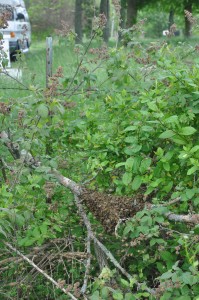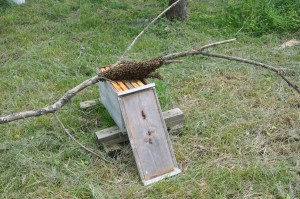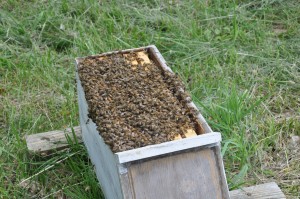I’m not been hearing a lot from beekeepers so far about swarming , but I suspect this is a heavy swarming year everywhere and not just at my apiary. I was talking on the phone Saturday evening with my bee keeping friend Larry (we were both on cell phones) and he sounded distracted. I asked him what he was doing and he said he was trying to find a queen in a swarm. Realizing that he had his head in bee hive, I told him good bye. But that prompted me to go to my apiary to look for swarms. I found a huge one, 20 feet up in cedar tree. The problem, in addition to the height, is that cedars are a real pain to retrieve swarms from because of all the branches and the prickly needles. I worked for an hour trying to get all the bees, and had only partly succeeded before dark. I told myself that they would still be there in the morning, and went into the house to watch a Reds baseball game, which turned out to be even less of a victory. The next morning, with the approval of my wife (we have a dual approval policy on any tree cutting at our place), I (or rather my son Mike) cut the top out of the cedar, and I completed the capture. I’m going to finish cutting down the cedar later. It will be the last group of bees I have to extract from that tree! It was the largest swarm I had ever seen, which was why I was anxious not to lose it. I hived it in a deep hive body, but immediately had to add a second deep.
This swarm followed the policy which all the swarms in my apiary seem to follow – mass high in a tree when swarming! I’m tempted to think that it’s a genetic thing, but suspect that it’s because of the tall ash trees around the hives. Unfortunately, the ash borer will probably solve this problem eventually. But yesterday I was in the apiary and saw an unusual amount of activity in front of a hive. This hive was a nuc which I had wintered, and I didn’t think it had built up enough to swarm. Wrong again! I stood and watched them come out and followed the cloud sure that they were headed for the tree tops. But no – they ended up landing on a stick I had tossed over the fence at the property line. (My adjacent neighbor is a cattle farm with an absentee owner.) This swarm, though small, ended up about two feet off the ground. Better than that, I was able to just pick up the stick and shake it into a nuc box. I returned the stick to its place near the fence; perhaps another swarm will find it.
I often think newer beekeepers often worry too much about swarming. That is because old beekeepers go on and on about losing swarms and about the honey they failed to make as a result. But stopping swarming is like stopping the wind. It’s not going to happen. We can do things such as keeping young queens and, better yet, making nucs, but swarming is an instinctive behavior of bees, and they will do it. Most of the time, despite swarming, we can still make a honey crop. I never talk about preventing swarming, but about reducing or slowing it. And I always conclude by saying, “Watch the trees!” Actually, beekeepers with a small number of hives, kept near their home have an advantage over those who are larger and have out yards (apiaries away from their residences). If your bees are near your house, you can check on them almost every day, and can catch most of the swarms they throw off. Compare this to a beekeeper with 200 hives in 10 apiaries. He may visit each yard once a week, if lucky, and will lose most of his swarms.
I mentioned making nucs to reduce swarming but, to be effective, this must be done before the bees decide to swarm, i.e. prior to the building of swarm cells. This year the swarming, like our heavy blooming, is so early that I’ve yet to make any nucs. It has not helped that my queen order was late in arriving. I plan to make up nucs later in the week ,and will write about the process in a post, including photos.




On March 6th of this year I cauight my first swarm, here in White House Tennessee. Very large and low to the ground, which was on the grape vines. Used my home made bee vac to get all making a tuff job easy. Since then I have captured 13 more todate. Three swarms larger than first. Have joined the smaller (ones) to make one colony. All are doing well so far. I had six hives in early Spring and now have eleven. Nectar flow is heavy here and I do feed 1 to 1 sugar and bee pollen patties. All of which is being consumed by the smaller colonies. The large super on the first captured bees has had a second large super placed on it since initial capture. I have never seen such activity in this area like this. Have examined my hives to find one hive does have Queen cells on lower bars, yet no others. Hive is strong, yet I know not where the other swarms may be coming from. I’m thankful for them in any case.
On a follow up…..
All hives are when in sight of my back deck, being home I do get the best chance to be aware of the goings on in the apiary. Have been making medium hive bodies and more nucs.
Hey Michael. I live in Springfield TN just down the road from you. All my hives have been swarming like crazy this year. We caught most of them. I suspect you have another bee keeper near you that couldn’t keep up with theirs. Good catching.
Thank You, I’ll check with Robertson County Bee Association to see if there is one, or know of one. Thanks again.
CHEERS!!! Michael